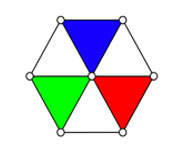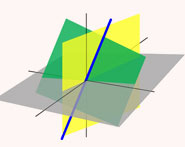


 تاريخ الرياضيات
تاريخ الرياضيات
 الرياضيات في الحضارات المختلفة
الرياضيات في الحضارات المختلفة 
 الرياضيات المتقطعة
الرياضيات المتقطعة
 الجبر
الجبر
 الهندسة
الهندسة 
 المعادلات التفاضلية و التكاملية
المعادلات التفاضلية و التكاملية 
 التحليل
التحليل
 علماء الرياضيات
علماء الرياضيات |
Read More
Date: 1-9-2020
Date: 2-12-2020
Date: 20-4-2020
|

The EKG sequence is the integer sequence having 1 as its first term, 2 as its second, and with each succeeding term being the smallest number not already used that shares a factor with the preceding term. This results in the sequence 1, 2, 4, 6, 3, 9, 12, 8, 10, 5, 15, ... (OEIS A064413). When plotted as a connect-the-dots plot (left figure), the sequence looks somewhat like an electrocardiogram (abbreviated "EKG" in medical circles), so this sequence became known as the EKG sequence. Lagarias et al. have computed the first 10 million terms of the sequence (Lagarias et al. 2002, Peterson 2002).
Every term appears exactly once in this sequence, and the primes occur in increasing order (Lagarias et al. 2002). The inverse permutation of the integers giving the sequence is 1, 2, 5, 3, 10, 4, 14, 8, 6, 9, 20, 7, 28, ... (OEIS A064664).

Lagarias et al. (2002) established the bounds
 |
for the  term
term  . For the first
. For the first  terms, whenever a prime
terms, whenever a prime  occurs, it is immediately preceded by
occurs, it is immediately preceded by  and followed by
and followed by  . This results in a three lines of points when the sequence is plotted without connecting the dots.
. This results in a three lines of points when the sequence is plotted without connecting the dots.
REFERENCES:
Lagarias, J. C.; Rains, E. M.; and Sloane, N. J. A. "The EKG Sequence." 11 Jun 2002. https://arxiv.org/abs/math.NT/0204011.
Peterson, I. "MathTrek: The EKG Sequence." Apr. 6, 2002. https://www.sciencenews.org/20020406/mathtrek.asp.
Sloane, N. J. A. Sequences A064413 and A064664 in "The On-Line Encyclopedia of Integer Sequences."



|
|
|
|
التوتر والسرطان.. علماء يحذرون من "صلة خطيرة"
|
|
|
|
|
|
|
مرآة السيارة: مدى دقة عكسها للصورة الصحيحة
|
|
|
|
|
|
|
نحو شراكة وطنية متكاملة.. الأمين العام للعتبة الحسينية يبحث مع وكيل وزارة الخارجية آفاق التعاون المؤسسي
|
|
|